Hi, and welcome to Line Sheet. Today, I did a quick-fire round with Marc Metrick,
the Saks Global C.E.O. who’s been overseeing the complex integration of Neiman Marcus. We covered everything from the late vendor payments to the downtown Dallas store kerfuffle. You may feel empathy for him; you may be further annoyed.
In other news, I share what’s going down at Louis Vuitton’s Texas factory, and an illuminating (if unscientific) vote for the best running tights on the market. It says a lot about the business of activewear.
Finally, I’ve got a very short update on
the Vanity Fair editor-in-chief search because… I’m going on vacation! Don’t worry, I’ll still be writing to you every day, with regular contributions from Sarah Shapiro and Rachel Strugatz. For the most part, though, I’m limiting my time on the computer as my family and I explore Tokyo. On that note, please don’t share recs (we’ve been before), but feel free to continue sending me tips!
Programming note: Tomorrow on Fashion
People, I’m joined by Jonathan Schley, a retail real estate advisor and longtime contributor to Highsnobiety. We’ll discuss the Prada-Versace deal, tariffs, and Glossier’s down round. Listen here and here.
Mentioned in
this issue: Marc Metrick, Saks Global, Richard Baker, Louis Vuitton, Bernard Arnault, running tights with pockets, Luca Guadagnino, Ruthie Rogers, Lululemon, Literary Sport, Anna Wintour, Vanity Fair, outer space, Adam Shapiro, The Studio, and many more…
|
|
|
A MESSAGE FROM OUR SPONSOR
|
GET NOTICED
Every detail of this iconic performance SUV has been labored over to communicate poise and
presence.
EXPLORE
|
|
|
Three Things You Should Know…
|
- Louis
Vuitton’s cowboy blues: I’ve received many, many notes regarding this Reuters report about the challenges at Louis Vuitton’s Alvarado, Texas, production facility. In short, the piece asserts that it is among the worst-performing factories run by the vertically integrated company. Reuters also reports that at
least one of Louis Vuitton’s factories in California may close by 2028. The gist is that it’s hard to train local workers in the U.S. to make even a pocket on a handbag, and it’s going to get harder.
You should read the whole thing, but here’s what I can add to the conversation, as someone who has long been covering Louis Vuitton’s U.S. manufacturing. In 2016, three years before the Texas facility opened, I Ubered over to the Louis Vuitton factory in San Dimas, California, while reporting
a story on local production. I wasn’t permitted inside—an LVMH P.R. person suggested that I visit one of their vineyards in Napa Valley instead—but I did get a peek at the facilities. They were very clean.
Anyway, repairs on existing products are a big reason these local factories exist, and it’s naive to think
LVMH is betting that the U.S. will produce a meaningful volume of items long-term. While there are arguments for local manufacturing—avoiding tariffs, sure, but also improved speed-to-market and a reduced environmental footprint—it’s incredibly difficult to find people willing to do these jobs in the U.S., let alone people with the necessary skills. I hear this time and again from executives, and not just those in the LVMH universe: It’s nearly impossible to get workers to even show up.
(According to the Reuters report, fewer than 300 people work at the factory.)
So the problem is not that Louis Vuitton and LVMH have failed to build a robust business in Alvarado, but rather that they hyped the opening of the factory for P.R. purposes. In 2019, LVMH chairman and C.E.O. Bernard Arnault, then-Louis Vuitton C.E.O. Michael Burke, and Alexandre Arnault all showed up for a ribbon-cutting ceremony with
then-President Trump, and Ivanka Trump and Jared Kushner. There are definitely people in Arnault’s inner circle who thought the trip was a bad idea. Perhaps it was worth it to appease Trump, but it just made people aware that the factory existed in the first place. The two (and I believe, at one time, three) facilities in California have been operating for decades without anyone noticing. Talk about quiet luxury.
- Lululemon’s pocket deal: On Saturday morning, as I ran around the Rose Bowl, I grew concerned about the tan line that was inevitably going to form around my right bicep in the place where my iPhone armband sits. (In the winter, even in Los Angeles, I typically run in long sleeves.) Then I had a doh! moment. Why not just buy some running tights and shorts with… pockets? I can’t really explain why this hadn’t occurred to me before, only to say that I do find the
pocket-rich tights to be less attractive. Anyway, I put a query out on Instagram, asking for recommendations besides Vuori and Alo, arguably the two most dominant activewear brands on the market. Over the course of 24 hours, the post received nearly 6,000 views (much higher than usual for me) and roughly 127 responses.
Amazingly, no one argued for Vuori and Alo. (Although one friend suggested it was “rude” to exclude Alo.) Among the 40 different brands that were mentioned, the
overwhelming winner was Lululemon (with 29 recs), which sells many different tights with pockets, including the Align, Wunder Train, Fast and Free, and
Swift Speed. Tied for second place were Athleta and Nike, with 12 recs each. (A lot of fashion people still wear Nike.) Next up was Beyond Yoga with seven recs. After that, Bandit and Tracksmith both received six nods. Those were followed up by On Running and Satisfy (four mentions each).
Literary Sport, the brand that launched a while back as an answer to activewear for people who like The Row, received a notable three mentions. (Plus a fourth, where someone asked me, “I wanna know who says Literary Sport and whether they’ve actually ever gone for a run.”)
Then there were a
ton of one-off or seconded mentions. (Fabletics, Gap, Old Navy, Uniqlo,
LNDR, Prism London, Laurel Canyon Tennis Club, Aerie… you get the point.) This was a wholly unscientific survey,
especially because I excluded two of the biggest activewear brands on the planet, and also accounts for my audience’s taste (see: overindexing on Literary Sport) and location (if we were in the U.K., there would be way more Sweaty Betty). But I do think Lululemon’s dominance is a marker of something—primarily, that no one has come close to challenging its dominance in this space. In the end, I bought a pair of Bandit tights because they were available at my local shop, Long Slow Distance.
- One more Vanity Fair update before I go: Someday—maybe after they actually hire someone—I’ll publish the list of your nominations for the next editor (or, erm, global editorial director) of Vanity Fair. You have
fascinating ideas and arguments for those ideas. (David Netto?) I also know that some of you have applied! Godspeed. I’m not going to jinx it by outing you. At least not yet.
My bet is on an internal candidate, partially because that’s the current chatter around One World Trade. (Not Will Welch, though. More on why not when I get back.) Also, Anna Wintour is going to want someone she understands and with whom she already has a
rapport. As you discuss this among friends—I’m finding that this topic is really bringing people together—I encourage you to consider one thing: Will this person look comfortable taking photos with celebrities at the Oscar party? If the answer is no, cross them off your list.
|
|
|
Since last year’s Saks-Neiman marriage, Saks Global C.E.O. Marc Metrick has become the
company’s convenient villain, blamed for withheld payments, layoffs, and store closures. Herewith, Metrick explains himself as he steers Saks Global through a rocky merger.
|
|
|
One of the biggest stories of 2025 was supposed to be the integration of Saks Fifth Avenue and Neiman Marcus.
And it has been a huge story, though not for the right reasons. Brands had been optimistic that they would quickly receive back-payments for the millions of dollars that some were owed from Saks Fifth Avenue and Saks.com. After all, Saks Global chairman Richard Baker raised $2.7 billion to close the deal last summer.
Instead, many are still waiting to get paid. Over the past five months, Saks Global C.E.O. Marc Metrick has faced a series of
threats to his empire: Not only does he still owe brands a tremendous amount of money—which he promises to start paying back in July—but he’s also reckoning with the fall of Hudson’s Bay Company in Canada, the closure of Neiman Marcus’s historic downtown Dallas location (a P.R. disaster), waves of layoffs, tariffs, and global recession fears. The yield on Saks’s $2.2 billion junk bond, due in 2029, jumped to 19 percent last week—a signal that the market is anticipating a potential default.
|
|
|
A MESSAGE FROM OUR SPONSOR
|
GET NOTICED
Every detail of this iconic performance SUV has been labored over to communicate poise and
presence.
EXPLORE
|
|
|
On a recent episode of
Fashion People, my twice-weekly podcast, Marc addressed all this, and more—but what I really wanted to talk about was the vendor payments issue. Here, you’ll find an excerpt from our full conversation (listen here), condensed and edited for
your convenience.
|
Lauren Sherman: On February 14, 2025, you sent
this letter that was read around the world, indicating your intention to change overall payment terms and delay already-owed payments. Can you explain why you owed companies so much money?
Marc Metrick: It goes back to the pandemic. HBC U.S. [Hudson’s Bay Canada U.S.] slowed down payments, shipping slowed down, and it became a flywheel. Business slows down, and then it just piles up and piles up and piles up. Along the way, there was
always comfort in the U.S. that the business would meet its expectations. There were no concerns in the U.S. about the business, but again, with 30-day payment terms, even on a good day, it’s hard. So there was just a lot of pressure put on the U.S. credit group. That’s how it sort of snowballed.
We remember when Barneys New York went bankrupt in the 2010s, but it also went bankrupt in the ’90s. So clearly something is wrong with the model. But can you explain why you believe
making the payment terms 90 days from receipt versus 30 days makes a difference?
The margin profile changed, the vendor allowance slowed down, every brand started building stores. We had to change this dynamic. Do I expect the brand partners to finance my business? No, I don’t. It’s not their job. But I can’t finance theirs, either.
Well, the one thing that I heard immediately was LVMH got preferential deals, Kering got
preferential deals. I mean, Chanel doesn’t wholesale with you, so I don’t know how that could be a preferential deal.
Neither does Louis Vuitton.
Well, LVMH does, though.
Yes, just a little bit.
So did you end up having to do a bunch of side deals with companies?
I’m not going to lie to people. People have different
deals. It was amazing when we put Neiman and Saks together. Do you think all the deals were the same? Do you think that when I opened up those vendor deals, and when I looked at the terms that different people had, that they were all identical? No. But payment terms are one thing. I don’t have to take any markdowns on Chanel. I don’t pay sales commission on Chanel. I don’t have to spend too much money marketing Chanel. I don’t have to introduce the Chanel brand to people. There’s a lot of
different things. So yes, did we make side deals? Yes. Am I willing to talk to any single brand partner? Yes. Because, look, there are new and emerging brands who can’t sustain this type of payment cycle. I’ll work with them.
|
Tossing aside the specific circumstances of the downtown Dallas Neiman Marcus store, you could argue,
if you’re a cold and callous person like I am, that that store should not be open. NorthPark [in the Dallas suburbs] is a powerhouse, and that’s where people go shopping. So, more broadly, how are you thinking about the store fleet, and how to manage it now that you are one company?
If there’s clear overlap, and there are easy places where you don’t need both—if you have a C or D store, why burn the
calories on it? But there’s not many of those. And the ones that everyone’s really interested in—whether it’s the ones in Bal Harbour or Boca Raton or Beverly Hills—these are powerful, powerful stores that do a lot of volume and make a lot of money. And it is not a math exercise—close one and just move all the volume. You saw that when Barneys closed in New York City. It’s not like Saks and Bergdorf picked up all that volume. It went poof into the night. Some to the brands, some to Ssense and
Matches, or whatever. We just don’t see a reason to disrupt something that’s working quite well.
|
|
|
Okay, I’ll be tracking your store count.
There will
be a rationalization. It’s going to be small. It’s not going to be what I think you and others might expect, and even some would hope. But there will be closures over the next five or six years.
You’ll have more layoffs as the business integrates, I assume?
A derivative, or a byproduct, of this combination is going to be redundancies. There were two C.E.O.s. I lost and Geoffroy [van
Raemdonck, former Neiman Marcus Group C.E.O.] won, and here I am. [Laughs.] But there are going to be redundancies across the organization. The goal for us is, we’ve got to do this properly and deliberately.
We’ve got to have the right talent. At the same time, we’ve got to treat these people the right way. These are hardworking people, who have all been at one of these two companies, you know, one year, five years, 10 years, 20 years, it
doesn’t matter. And you have to understand that you have to do it right, and you have to treat them right. It’s just taking time to do that. So there will be reductions.
It’s December 2025. There’s no way you haven’t started paying people back, right?
There’s no way. No caveat.
|
What I’m Reading… and
Listening to…
|
Jerome, the 91-year-old father-in-law of Puck’s very own (and very well-dressed)
Alex Bigler, is the star of the latest Alex Mill campaign. He wears the garment-dyed work jacket so well that he may even convert me. [Instagram]
I admire Laura Kim and Fernando Garcia’s ability to
enter conversations outside of the fashion bubble. However, I’m with Olivia Munn on this girls trip to outer space. (As in, it’s in incredibly poor taste.) [NY Times]
The Louis Vuitton–Murakami collab
couldn’t save LVMH’s fashion and leather goods division in the first quarter, which was down 4 percent from the same period a year earlier. (Dior, according to Bernstein analyst Luca Solca, looks to be the problem.) Watches and jewelry performed the best, but the parent company missed analyst estimates overall. Another tough situation is duty-free retailer DFS, which was described as “suffering” in the LVMH literature. Anyway, the Jonathan
Anderson-to-Dior announcement is going to help the stock, whenever it finally happens. [Check Out the Deck for Yourself]
Amanda Mull on the fact that the U.S.’s entire economy is driven by consuming cheap goods.
[Bloomberg Businessweek]
If you want to understand why the next editor-in-chief of Vanity Fair probably won’t be someone very interesting, I suggest you listen to this conversation between Challengers director Luca Guadagnino and Ruthie Rogers, the owner of The River Café. When serving as restaurant critic for Vanity Fair Italia, Guadagnino claims, two of his negative reviews were killed because the editor told him
that they have to be nice to everyone. [Ruthie’s Table 4]
Formerly owned by New Guards Group, Ambush has been bought back by Yoon and Verbal. I suspect we’ll see this happen with several other NGG brands as well. [Inbox]
L52, Adam Shapiro’s London-based comms agency (which has made inroads in the U.S. too), is opening a
Mumbai office, now that multiple upscale department stores selling Western luxury goods are opening in India. [WWD]
Mattie Kahn on Republican hair. (With an appearance from me!) [Town & Country]
I truly hope the costumes in The Studio inspire entertainment executives to dress better. [NY
Times]
|
Until tomorrow,
Lauren
P.S.: We are using affiliate links because we are a business. We
may make a couple bucks off them.
|
|
|
Need help? Review our FAQ page or contact us for assistance. For brand partnerships, email ads@puck.news.
You received this email because you signed up to receive emails from Puck, or as part of your Puck account associated with . To stop receiving this newsletter and/or manage all your email preferences, click here.
|
Puck is published by Heat Media LLC. 107 Greenwich St, New York, NY 10006
|
|
|
|










